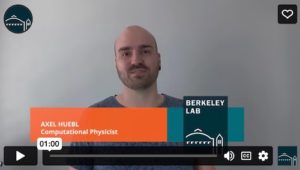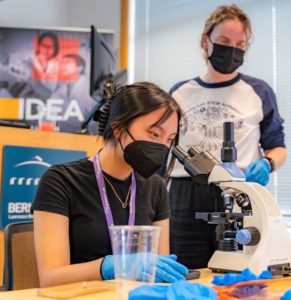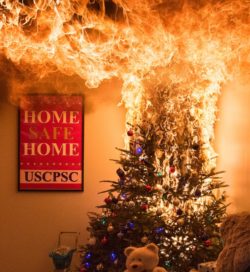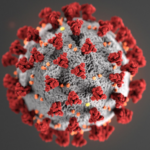Director’s Corner
SCIENCE FEATURES
• BELLA’s Interaction Point 2 Complete
• ALS-U Construction Start Approved
HONORS AND AWARDS
• ATAP-Led Team Wins Gordon Bell Prize
• Multi-Lab Safety Week Awards
• DeChant, Natal Win AAC Student Poster Prizes
LEADERSHIP APPOINTMENTS
• Geddes Named to P5
• APS DPB, DPP Roles for Prestemon, Turner, Geddes
OUTREACH & EDUCATION
• Outreach and Mentoring Opportunities
• Social Media Highlights
WORKPLACE LIFE
• Winter Food Bank Drive
IDEA
• Making Poster Presentations Accessible
ICYMI
• Summer Internship Deadline Jan. 10
• Safety Training Required for Lab Vehicles
• Phishing Scams: Don’t Take the Bait
SAFETY: THE BOTTOM LINE
• Holiday Safety
• Avoiding Slips, Trips, and Falls
PUBLICATIONS
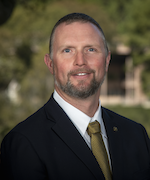
The year ends on a tremendously future-oriented note for ATAP.
Facilities and research endeavors throughout the sciences rely on advanced computer simulations. Researchers in our Accelerator Modeling Program led an international team, including colleagues elsewhere at Berkeley Lab, that was recognized with a tremendous honor: the Association for Computing Machinery’s Gordon Bell Prize. The prizewinning work, performed under the aegis of the Exascale Computing Project, boosts the understanding of plasma-based accelerators and will benefit fields ranging from FLASH radiotherapy to future particle colliders for high-energy physics.
Further good news came in the form of Critical Decision 3 approval for the Advanced Light Source Upgrade. The CD-3 milestone in the DOE’s project-management process amounts to a go-ahead for construction of this major upgrade of the Advanced Light Source—the Lab’s biggest project in three decades. The ALS-U project, like the design of the present ALS and its ongoing enhancement and operation, has deep ATAP involvement. The result will be a state-of-the-art user facility providing brighter beams for research into new materials, chemical reactions, and biological processes.
Our BELLA Center has completed Interaction Point 2, which will use the BELLA Petawatt laser to provide intense pulses of protons and ions. This capability will expand the BELLA Center’s capabilities into new areas, including studies of particle acceleration, extremely hot plasmas, cancer treatment techniques, and materials for quantum science. This is the second major enhancement to the BELLA Center in recent months, building on the Second Beamline.
Leadership in the strategy as well as the science and technology of our field is an important role of ATAP. I recently had the honor of being named to the Particle Physics Project Prioritization Panel (“P5”), which advises both DOE and the National Science Foundation, as well as to the Chair-line of the American Physical Society (APS) Division of Plasma Physics. Soren Prestemon, ATAP’s Deputy Division Director for Technology, was elected to the APS Division of Physics of Beams (DPB) Chair-line, and Marlene Turner, a research scientist in ATAP, was elected Early Career Member-at-Large on the DBP Executive Committee.
Another major part of our mission is nurturing the young talent that will build the future we envision. I am proud to announce that two ATAP graduate students came back from the recent Advanced Accelerator Concepts Workshop with Best Student Poster recognition for their presentations.
This is a season for giving, and opportunities abound. Let me thank everyone in ATAP who helped the Laboratory to its unprecedented results in the Winter Food Bank Drive. With continued generosity we can reach our ambitious target in helping with this widespread community need. There are also a variety of opportunities—something to match every skill set and schedule—to help develop the next generation of STEM professionals by volunteering for the Lab’s K-12 programs.
Finally, as we prepare for the holidays, let’s remember to be safe and healthy amid winter-weather hazards and a “tripledemic” of COVID, RSV, and flu.
I wish everyone a safe, happy, and relaxing winter break, and I very much look forward to a New Year of exciting progress.
From Qubits to Potential Cancer Treatments: “iP2” Laser Upgrade Opens New Research Possibilities
December 1, 2022 news release by Lauren Biron, Berkeley Lab Strategic Communications
A new addition to the Berkeley Lab Laser Accelerator Center means researchers can explore extreme plasmas, radiation biology, materials for quantum computers, and beyond
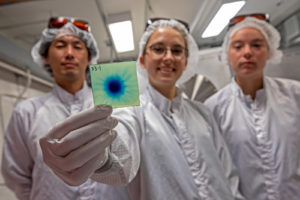
Kei Nakamura, Lieselotte Obst-Huebl, and Anya Jewell (from left) show a radiochromic film that has been hit by the proton beam at BELLA’s iP2. (Credit: Marilyn Sargent/Berkeley Lab)
Things are looking brighter than ever at the Berkeley Lab Laser Accelerator (BELLA) Center run by the Department of Energy’s Lawrence Berkeley National Laboratory. A recently completed upgrade will expand the center’s capabilities into new areas, including studies of particle acceleration, extremely hot plasmas, cancer treatment techniques, and materials for quantum science.
The new experimental area, known as Interaction Point 2 (iP2), will use the lab’s petawatt laser to provide intense pulses of protons and ions – building on the center’s expertise in accelerating electrons and lower-energy protons.
“At iP2, we can focus the laser to a very small spot size, which makes it about 1,000 times brighter,” said Eric Esarey, director of the BELLA Center. “Creating this extreme intensity opens up a wide range of physics research and potential applications, like a new technique that could revolutionize radiotherapy for cancer treatment.”
Following two years of installation, researchers successfully commissioned iP2 and produced high-energy ion beams this fall. The upgrade expands opportunities for scientists who use DOE’s LaserNetUS, a collection of laser facilities across the United States.
“We’re ushering in a new era of high-intensity laser experiments,” said Cameron Geddes, director of Berkeley Lab’s Accelerator Technology and Applied Physics (ATAP) Division, which manages the BELLA Center. “This is a great milestone that broadens the whole science reach of the facility and the possibilities for our field.”
The upgrade, funded through DOE’s Fusion Energy Sciences program, is the second completed at BELLA in 2022. This summer, teams also finished adding a second beamline where researchers plan to stack laser-powered modules to make small, high-energy electron accelerators.
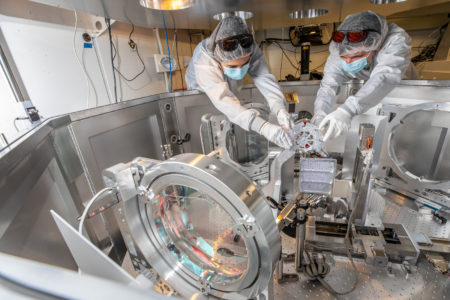
Postdoctoral researcher Sahel Hakimi and graduate student Jared De Chant (from left) make adjustments to iP2 at BELLA. The new facility will expand research capabilities for Berkeley Lab and the LaserNetUS community. (Credit: Marilyn Sargent/Berkeley Lab)
Cancer cells, qubits, and magnetic tornadoes
Researchers already have a number of experiments lined up at iP2 that will take advantage of the laser’s high-energy and its ability to fire quickly (about once per second), delivering particle blasts that last femtoseconds (quadrillionths of a second). The system at iP2 can also focus the laser down to a minuscule size: about 3 microns, a fraction of the width of a human hair.
One of the first experiments will explore what’s known as the FLASH effect, a phenomenon where radiation delivered by protons in an intense, short burst can kill cancer cells while sparing the healthy tissue nearby. In 2020, researchers at BELLA’s original interaction point (iP1) saw promising results looking at thin layers of cells in Petri dishes. They now plan to use protons with more energy to study the FLASH effect in thicker skin and tumor tissue.
“We are investigating the potential of using these laser-accelerated protons for radiotherapy, which would require significantly higher proton energies to penetrate deep into the human body,” said Lieselotte Obst-Huebl, a research scientist in ATAP at Berkeley Lab who led the installation work at iP2. “This is basic research and is in its infancy, but it could potentially someday be a powerful tool in our toolkit.”
Other groups are interested in using the facility to create and test new materials. These could be useful in making qubits, the building blocks of quantum computers, or in high-temperature superconductors, which would carry electricity efficiently without needing to operate in extreme cold. Researchers plan to fire the laser into thin sheets of material such as boron or gold, accelerating the resulting ions and embedding them in targets like silicon wafers or synthetic diamonds. They can then study how these doped materials respond and see whether they have any helpful properties.
Teams are also planning to explore an area known as high energy density science: the study of matter under extreme pressure or density. Among them are certain plasmas, gas-like collections of electrically charged particles. Understanding these incredibly hot (relativistic) plasmas made in the lab could help advance fusion energy sciences, studies in astrophysics (like how stars are born), and the next generation of particle accelerators.
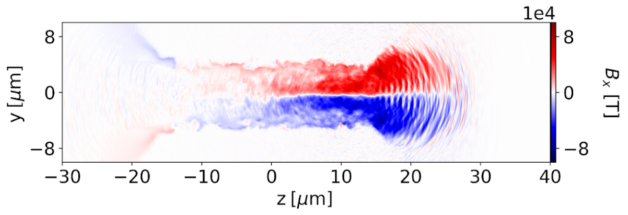
This simulation shows magnetic vortex acceleration. The laser pulse comes from the left and passes through a target that is just thick and dense enough to absorb nearly all of its energy. On the other side, it generates a plasma channel with strong magnetic fields that can accelerate an intense proton beam. (Credit: Sahel Hakimi, Axel Huebl, Stepan Bulanov/Berkeley Lab)
Scientists at BELLA are already combining lasers and plasmas to reduce the size of particle accelerators for lightweight particles such as electrons. New techniques could further improve their power. Researchers will set up experiments at iP2 to study one method called magnetic vortex acceleration (MVA), which could produce more energetic proton and ion beams. They’ll test out special thin, foam-like targets that will interact with the laser to generate rotating magnetic fields that swirl through the plasma like a tornado.
“With MVA, the idea is to absorb as much laser energy as possible into the electrons to create this magnetic vortex through the target that then accelerates the ions with it,” Obst-Huebl said. Boosting particles to higher energies in a shorter distance means new applications and potentially lower-cost ways to explore the fundamental workings of our universe.
Simulations and expansions
Most of the processes studied at BELLA take place over incredibly short periods: around one millionth of one millionth of a second. As a result, it can be difficult to physically measure every aspect, so scientists need to pair their experiments with simulations on some of the most powerful computers in the world to better understand what’s happening.
“It’s complicated physics, and 3D simulations of this type of experiment are relatively new,” said Jean-Luc Vay, head of the ATAP Accelerator Modeling Program at Berkeley Lab. “We’re ready to do the simulations on new exascale computers in support of iP2 experiments.”
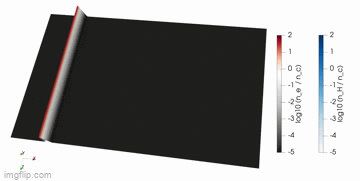
This 3D simulation shows a BELLA laser pulse interacting with a 50-nanometer-thick foil target. The laser pulse (from left) expels electrons (red) from the target. This causes strong magnetic fields that can accelerate ions (blue) in what’s known as a Coulomb explosion. The simulation was created using the Berkeley Lab-led code WarpX at the National Energy Research Scientific Computing Center. (Credit: Marco Garten and Axel Huebl/Berkeley Lab)
Computer modeling was also key to successfully installing the iP2 upgrade during the pandemic, when fewer people were on site. Simulations helped the team plan the experimental setup to measure key plasma and beam properties, and can be used to prepare for future experiments at iP2.
“We have this nice setup, but we don’t yet have all the diagnostic tools,” said Axel Huebl, a computational physicist in ATAP at Berkeley Lab. “So, in parallel with the experiments, we’re getting ourselves ready to build a fully digital twin so that we can measure as many virtual diagnostics in the simulations as possible.”
The simulations will let researchers look at detailed plasma behaviors at any timescale, which they can then compare with measurements from experiments. The results will prove or improve scientists’ best models and feed into other areas of science.
Researchers can submit proposals through LaserNetUS to conduct research at the BELLA Center and take advantage of the expansion at iP2.
“People can bring detectors and new targets and get supported by our team here,” said Kei Nakamura, the associate deputy director for experiments at the BELLA Center. “They can propose pure acceleration experiments or applications of accelerated particle beams. Topics we don’t even know now will be happening in the future.”
Advanced Light Source Upgrade Approved to Start Construction
Editor’s Note: Berkeley Lab is pursuing a major upgrade of the Advanced Light Source, an effort that (like the design of the present ALS and its ongoing enhancement and operation) has deep ATAP involvement. This story was first published as a news release November 15, 2022 by Lauren Biron, Berkeley Lab Strategic Communications
Berkeley Lab’s biggest project in three decades now moves from planning to execution. The ALS upgrade will make brighter beams for research into new materials, chemical reactions, and biological processes.
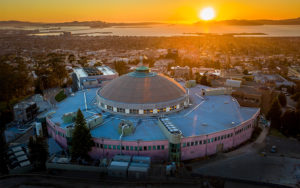
The upgrade to the Advanced Light Source at Berkeley Lab will add two new particle accelerator rings within the iconic building’s footprint. (Credit: Thor Swift/Berkeley Lab)
The Advanced Light Source (ALS), a scientific user facility at the Department of Energy’s Lawrence Berkeley National Laboratory (Berkeley Lab), has received federal approval to start construction on an upgrade that will boost the brightness of its X-ray beams at least a hundredfold.“The ALS upgrade is an amazing engineering undertaking that is going to give us an even more powerful scientific tool,” said Berkeley Lab Director Michael Witherell. “I can’t wait to see the many ways researchers use it to improve the world and tackle some of the biggest challenges facing society today.”
Scientists will use the upgraded ALS for research spanning biology; chemistry; physics; and materials, energy, and environmental sciences. The brighter, more laser-like light will help experts better understand what’s happening at extremely small scales as reactions and processes take place. These insights can have a huge array of applications, such as improving batteries and clean energy technologies, creating new materials for sensors and computing, and investigating biological matter to develop better medicines.
“That’s the wonderful thing about the ALS: The applications are so broad and the impact is so profound,” said Dave Robin, the project director for the ALS upgrade. “What really excites me every day is knowing that, when it’s complete, the ALS upgrade will enable researchers to make scientific advances in many different areas for the next 30 to 40 years.”
The DOE approval, known as Critical Decision 3 (CD-3), formally releases funds for purchasing, building, and installing upgrades to the ALS. This includes constructing an entirely new storage ring and accumulator ring, building four feature (two new and two upgraded) beamlines, and installing seismic and shielding upgrades for the concrete structure housing the equipment. The $590 million project is the biggest investment at Berkeley Lab since the ALS was built in 1993.
“Our team has spent years designing every single magnet, vacuum system component, RF [radio-frequency] cavity, power supply, and the rest of the custom design,” said Robbie Leftwich-Vann, Berkeley Lab’s project manager for the upgrade. “It’s exciting to get off the paper and into the world of installing things and making it real.”
Brighter beams, better science
The ALS generates X-rays by circulating electrons through a 600-foot-circumference storage ring. As the electrons travel through this series of magnets, they radiate light along beamlines to stations where researchers conduct experiments. The light comes in many wavelengths, but the ALS specializes in “soft” X-rays that reveal the electronic, magnetic, and chemical properties of materials.
The upgraded ALS will use a new storage ring with more advanced magnets that can better steer and focus the electrons, in turn creating brighter, tighter beams of light. This will squeeze the X-ray beams from about 100 microns (thousandths of a millimeter) to only a few microns wide, meaning researchers can image their samples with even finer resolution and over shorter timescales. It’s like switching from a cell phone camera in dim light to a top-of-the-line high-speed camera in vivid daylight.
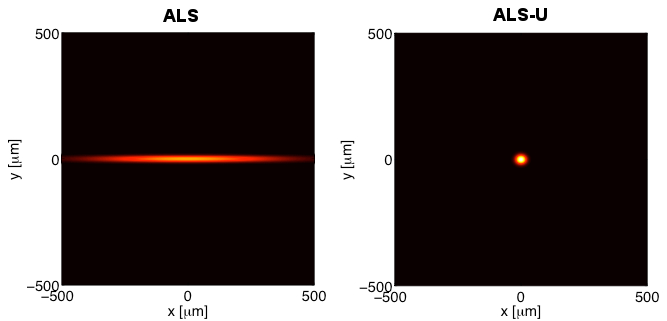
The beam profile of Berkeley Lab’s Advanced Light Source today (left), compared to the highly focused beam (right) that will be available after the upgrade. (Credit: Berkeley Lab)
“With the upgrade, we’ll be able to routinely study how samples change in 3D – something that is currently very difficult to do,” said Andreas Scholl, a physicist at Berkeley Lab and the interim division director for the ALS. “One of our goals is to find and develop the materials that will be essential for the next generation of technologies in areas like energy storage and computing.”
With 40 beamlines and more than 1,600 users per year, the ALS supports a variety of research. For example, researchers can look at how microbes break down toxins, study how substances interact to produce better solar cells or biofuels, and test magnetic materials that could have applications in microelectronics. Teams will build two new beamlines optimized to take advantage of the improved light, and realign and upgrade several existing beamlines.

The ALS will use a technique called “on-axis swap-out injection” developed by scientists at Berkeley Lab. It will enable the accumulator and storage rings to work together to create incredibly bright, ordered beams for research that can reveal nanoscale details in materials and reactions.
One crucial element of the upgrade already underway is a second ring known as the accumulator, which will take electrons made by the accelerator complex and prepare them for the new storage ring. Construction began on the accumulator in 2020 with a special advance approval known as CD-3a. By installing and testing the accumulator first, teams can minimize how long ALS operations will be paused to complete the upgrade.
Building a ship in a bottle
If you’ve ever tried to maneuver large furniture into a second-floor apartment, you understand a taste of what installing the new ALS storage ring will involve.“The biggest challenge for ALS-U is space,” said Daniela Leitner, who leads the removal and installation team for the project. “We are literally measuring whether we can put a hand into a particular area.”Many elements in the accelerator tunnel can’t be moved, including the new accumulator ring that will run along the inner tunnel wall. Experts have used extensive modeling and simulations to make sure that the current storage ring can be safely removed along designated access paths and replaced with the new rafts of magnets.
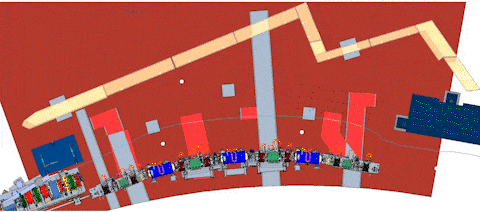
This animation shows a section of storage ring traveling through the accelerator tunnel. The accumulator ring is visible at the bottom. Simulations ensure all the different pieces of the upgrade will be able to travel in and out of the cramped space. (Credit: Christopher Bullock/Berkeley Lab)
Over the next three years, teams will procure and build all of the pieces for the new storage ring and other improvements. With everything prepared, the ALS will enter roughly one year of “dark time” for installation and initial commissioning.
“When the accelerator shuts down, the clock starts,” Leitner said. “Things need to run like a choreographed ballet.”Four teams working in parallel will strip out the current ALS storage ring. That means moving almost 500 tons of equipment, including magnets, cables, and support girders (which will need to be plasma cut into three pieces before they can be extracted). Then they’ll move in 500 tons of state-of-the-art equipment, carefully connect all the components, and bring an improved ALS back to life. It will then be the most intense source of coherent (laser-like) soft x-rays in the world.
“Preparing for this upgrade has been a lab-wide effort that is going to have a great impact on the scientific community,” Witherell said. “I congratulate the entire ALS-U team on their commitment and hard work.”
Take a virtual tour of the existing Advanced Light Source storage ring.
Use your mouse to navigate the tunnels of the ALS. (Credit: Matterport for Berkeley Lab)
The Advanced Light Source is a DOE Office of Science User Facility.To learn more about ALS-U:
• Overview: The Advanced Light Source Upgrade (ALS-U) project
• Video: Toward a New Light: ALS Upgrade Project Moves Forward
HONORS AND AWARDS
ATAP-Led International Team Wins ACM Gordon Bell Prize
Carl A. Williams, December 14, 2022
Based on a November 18, 2022 article by Patrick Riley, Berkeley Lab Computing Sciences

The winning team included Berkeley Lab’s Jean-Luc Vay, Axel Huebl, Kevin Gott, Rémi Lehe, Andrew Myers, and Weiqun Zhang, along with Luca Fedeli (CEA), France Boillod-Cerneux (CEA), Thomas Clark (CEA), Conrad Hillairet (ARM), Stephan Jaure (Atos), Adrien Leblanc (ENSTA Paris), Christelle Piechurski (RENCI), Mitsuhisa Sato (RIKEN), Neil Zaïm (CEA), and Henri Vincenti (CEA). [Credit: Jo Ramsey for SC22]
The prestigious award, presented to the team on November 17, 2022, comes with $10,000 in prize money and recognizes outstanding achievements in high-performance computing applied to challenges in science, engineering, and large-scale data analytics.
The research described in the winning paper, “Pushing the Frontier in the Design of Laser-Based Electron Accelerators with Groundbreaking Mesh-Refined Particle-In-Cell Simulations on Exascale-Class Supercomputers,” could help revolutionize radiotherapy treatments and, eventually, lead to major improvements for the next generation of particle accelerators devoted to high-energy physics. Their new simulation code (computer program), called WarpX, could see application in several areas of research.
“We are so excited to receive the award,” said Vay,” and is recognition of all of our hard work in supercomputing as well as pushing new ideas in advanced algorithms and physics.”
Pushing the boundaries of laser-based electron accelerators… and of codes
The team led by Jean-Luc Vay, head of ATAP’s Accelerator Modeling Program, collaborated with the team of Henri Vincenti, physicist and research director at CEA (the French Alternative Energies and Atomic Energy Commission) and other key organizations.
Vay said the research, which builds on and extends earlier work by his and Vincenti’s teams, presents a first-of-kind mesh-refined massively parallel particle-in-cell (PIC) code for kinetic plasma simulations, optimized on a quartet of supercomputers that includes Frontier, Fugaku, Summit, and Berkeley Lab’s Perlmutter. “In addition to melding mesh refinement with PIC codes, developing such a simulation code that runs efficiently at scale is completely new.”
“We’re really pushing here – in three directions,” Vay added. Those directions are improving the state of the art in particle accelerators, notably including laser-driven machines like those being developed at ATAP’s BELLA Center, while at the same time operating on the cutting edge of algorithms and developing a versatile code that is compatible with different types of supercomputers.
WarpX “enabled 3D simulations of laser-matter interactions on Frontier, Fugaku, and Summit, which have so far been out of the reach of standard codes,” the researchers write in the paper’s abstract. “These simulations helped remove a major limitation of compact laser-based electron accelerators, which are promising candidates for next-generation high-energy physics experiments, ultra-high dose rate FLASH radiotherapy, and other applications.”
Improved radiotherapy in a FLASH
In FLASH radiotherapy, a therapeutic dose is delivered in a very short time (a few seconds) at a much higher dose-rate than in conventional treatment protocols. After decades of anecdotal reports on the FLASH radiotherapy effect, more recent experiments have demonstrated a strong difference in sensitivity of healthy and unhealthy tissues to ionizing radiation delivered within short and bright pulses. However, to date, mechanisms behind the benefits of ultra-high dose rate radiotherapy have not been elucidated. This understanding requires a deeper insight into the basis of radiation toxicity on biological samples at disparate timescales, ranging from the femtoseconds (molecule excitation) to the hour (cellular response) and beyond.
Toward this end, the teams led by Vay and Vincenti used complex WarpX simulations to model a novel conceptual design of a laser-based electron injector and accelerator. This design can produce highly charged and very short particle electron beams of high quality that have the potential to deposit a large enough therapeutic dose at ultra-high peak dose rates in tumor cells without damaging other cells.
By using plasma mirrors, the team’s accelerators can deliver a much larger dose of energy in a much shorter time than current conventional methods. Moreover, in order to penetrate deeper into the human body and treat tumors, very large and costly accelerating structures are currently necessary.
“With laser plasma accelerators,” Vincenti said, “we can shrink the distance and enable very high-energy electrons to … democratize, let’s say, FLASH radiotherapy in medical centers at a cheaper cost and at a smaller scale.”
Other potential applications include the building of miniature x-ray free electron lasers for the science of ultrafast phenomena, as well as the development of particle colliders that could be more compact and — the hope is — cheaper than the current generation. To be sure, putting the HEP applications into practice may still take decades.
“This is, I would say, really at the research level of maturity, and computer simulations are key to establishing that it can be done,” Vay said. “It’s very promising.”
Labwide and international synergy of expertise for better modeling
Modeling the project presented a challenge. The main obstacle in modeling the plasma mirror design stemmed from the huge interval of spatial and temporal scales, the scientists noted. To help overcome that hurdle, the team used WarpX, a code developed via their ECP project, Vay noted. WarpX combines the adaptive mesh refinement (AMR) framework AMReX, developed at Berkeley Lab, with novel computational techniques. AMR is akin to a computational microscope, allowing researchers to zoom in on specific regions of space. Berkeley Lab’s Andrew Myers and Weiqun Zhang, both key members of the AMReX development team, are co-authors on the WarpX paper.
This short video celebrating the unveiling of the National Energy Research Supercomputing Center’s Perlmutter system features Axel Huebl and WarpX simulations of particle accelerators. The Accelerator Modeling Program’s WarpX code had the honor of being among the first batch of jobs in the inaugural run of Perlmutter at its May 27, 2021 dedication.
“AMReX is a numerical library that helps us implement physical block-structured mesh refinement algorithms,” said Axel Huebl, a computational physicist at Berkeley Lab who is now a lead developer of WarpX and co-lead author of the Gordon Bell paper. “Mesh refinement enables us to focus the computational power on the most interesting parts of a simulation, while staying effective for the larger, macroscopic evolution of, for instance, the plasma physics we model.”
Though work on this paper began in the spring of last year, its foundation was laid through the group’s affiliation with the ECP. “It’s really years of hard work from many people,” Vay said, adding that the team recently also had to pull long shifts to make efficient use of the various supercomputers when they gained access for brief windows of time.
Thanks to the ongoing collaboration through CEA and RIKEN, the researchers had full access to Fugaku, located in Japan, for 12-hour spans. “We had to stay connected on the machine to follow our simulations,” said lead author Luca Fedeli, a plasma physicist, WarpX developer, and currently a post-doc at CEA. “So we had like 12-hour Zoom calls at weird times.”
A broad spectrum of emerging and potential applications
WarpX is a cutting-edge software platform developed under Vay’s leadership within DOE’s Exascale Computing Project (ECP) for the modeling of plasma accelerators. It is now being leveraged by the Collaboration for Advanced Modeling of Particle Accelerators (CAMPA)—also led by Vay, and part of DOE’s Scientific Discovery through Advanced Computing (SciDAC) research program—to speed up the modeling of all types of accelerators. Ongoing support of the capabilities developed in WarpX, and its wider ecosystem beyond the ECP project, will be vital to the research and development of future accelerators. According to Vay, the list of research areas that could benefit from WarpX is growing rapidly.
“It is already being used by our collaborators in the computational physics division to simulate the physics of pulsars,” he said.
There is also a spin-off of WarpX, called the Adaptive mesh Refinement Time-domain ElectrodynaMIcs Solver), or ARTEMIS, he noted, which couples the Maxwell’s equations implementation in WarpX with classical equations to simulate the behavior of quantum materials behavior and could lead to next-generation microelectronics.
ATAP researchers are working with AMReX to build a software stack called Beam, Plasma & Accelerator Simulation Toolkit (BLAST) comprising flexible modules that can be used for different applications, said Huebl. “Some of these modules, for example, are now leveraged in the ImpactX project.” The project is part of the Laboratory Directed Research and Development program and aims to improve the performance of linear accelerators and accelerator rings.
The team plans to investigate how WarpX could be used in simulations involving 20 to 50 consecutive laser plasma accelerators stages. The work will aim to create better electron beams for applications in radiotherapy and the new colliders.
“We also are also looking to extend the method beyond laser plasma accelerators to investigate ion acceleration and solid target interaction, for example, as used in fusion research,” said Rémi Lehe, a researcher at Berkeley Lab and a co-author of the Gordon Bell Prize winning paper.
Mesh refinement, he continued, would be “extremely useful not only in conventional accelerators but also in nuclear fusion technologies,” which is a key area of research for the DOE and “for which WarpX is also well positioned.”
The paper’s other co-authors include France Boillod-Cerneux, deputy at the CEA’s Fundamental Research Department regarding numerical simulations; Thomas Clark, a Ph.D. student at CEA; Kevin Gott, a NERSC staff member working in the User Engagement Group; Conrad Hillairet, with ARM; Stephan Jaure, with Atos; Adrien Leblanc, with ENSTA Paris; Myers, a member of the Center for Computational Sciences and Engineering at Berkeley Lab; Christelle Piechurski, the Chief HPC project officer for GENCI; Mitsuhisa Sato, deputy director of RIKEN Center for Computational Science; Neil Zaïm, a postdoc at CEA; and Weiqun Zhang, a senior computer systems engineer at Berkeley Lab.
To explore further…
- Berkeley Lab’s Physical Sciences Area has published a news article on the achievement.
- Read the technical paper on the prizewinning work.
- The Exascale Computing Project podcast Let’s Talk Exascale devoted a recent episode to WarpX, interviewing Vay, Huebl, Vincenti, and Fedeli.
Multi-Lab Safety Week Honors Top Performers
Carl A. Williams and Patricia M. Thomas, December 14, 2022
The success of our annual Safety Week, which this year included magnet programs at Fermilab and Brookhaven, is built on an all-hands effort, but each year, some stand out for exceptional dedication and the quality of their contributions. To promote ongoing safety-culture awareness and maintain the momentum of Safety Week, we honor an outstanding individual worker and the top-performing team for outstanding safety and organization effort.
Individual Award: Reed Teyber
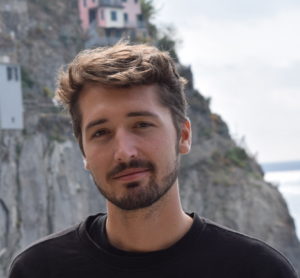
Teyber: “Most helpful to others”
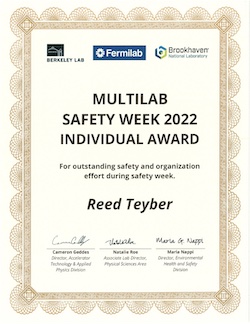
Reed Teyber, a research scientist in the Superconducting Magnet Program, received the individual award, honoring the person most helpful to others in Safety Week efforts.
His co-workers reported that he more than lived up to his reputation as a dependable year-round contributor to ATAP safety efforts; during Safety Week, he went the extra mile, including leading QUEST efforts in Building 58 and participating in a Management Walkaround in Building 71.
Team Award: BACI

A winning combination for safety. Clockwise from top left: Yilun Xu, Tong Zhou, Russell Wilcox, Qiang Du, Dan Wang, Gang Huang, and Neelay Fruitwala

Team honors go to the team representing the laser lab and electronics shop of the Berkeley Accelerator Controls and Instrumentation (BACI) Program for their performance in work-area cleanup and their commitment to workplace safety. Their task involved Building 71-170 and 170A, where a wide variety of laser experiments and related electronics work are underway. They were selected for this honor by division management, after final walkthroughs and reports from all the teams.
These honors were the result of pleasantly difficult decisions in assessing the excellent contributions of so many people across the three laboratories. Let’s maintain the momentum on Safety Week’s themes of clean and well-organized workspaces and up-to-date training, and have another year of doing great science safely.
Natal, DeChant Take Student Poster Honors at Advanced Accelerator Concepts Workshop
Carl A. Williams, December 14, 2022
Two ATAP doctoral students, Joseph Natal and Jared De Chant, whose work includes research carried out at ATAP’s BELLA Center, were awarded best student poster prizes at this year’s Advanced Accelerator Concepts Workshop (AAC2022). The workshop was held 6-11 November 2022 in Hauppauge, NY.
Additionally, Lauren Cooper, who worked with BELLA Center with the support of an Office of Science Graduate Student Research (SCGSR) fellowship, won for a poster based on work she performed as part of her graduate studies at the University of Michigan.
Joseph Natal

Joseph Natal
Natal is researching laser and electron beam control technologies and diagnostics for laser-plasma accelerators at the University of Nebraska-Lincoln. Before starting his Ph.D., he interned at Berkeley Lab from June 2019 to August 2020.
His poster presentation, “High-bandwidth image-based predictive laser stabilization via optimized Fourier filters,” was judged the best in Working Group 5 – Beam Sources, Monitoring, and Control. The research, carried out at Berkeley Lab, demonstrates how a predictive control algorithm that utilizes Fourier filters can provide sub-micrometer precision for laser-pointing stabilization. The technique could augment conventional control algorithms by overcoming bandwidth limitations.
Jared DeChant
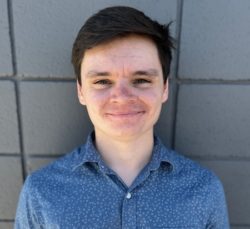
Jared DeChant
A first-year Ph.D. student at Michigan State University and research assistant at Berkeley Lab, DeChant is working on novel beam diagnostics and instrumentation, laser-plasma acceleration of electrons and ions, and dosimetry for various environments, including synchrotron light sources.
His paper, “Design Optimization of Permanent-Magnet Based Compact Transport Systems for Laser-Driven Proton Beams,” was awarded the best poster presentation in Working Group 6 – Laser-Plasma Acceleration of Ions. The work presents performance evaluations of transport beam simulations on various compact transport designs that utilize compact permanent magnets for the BELLA iP2 proton beamline.
LEADERSHIP APPOINTMENTS
Geddes Named to P5
Joe Chew, December 14, 2022
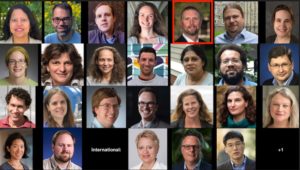
The P5 panel
ATAP Division Director Cameron Geddes is among those named to the upcoming Particle Physics Prioritization Panel (“P5”).
The charge to the P5 panel, as indicated in these slides from chair Hitoshi Murayama of the University of California-Berkeley and the Berkeley Lab Physics Division, is to develop an updated strategic plan for U.S. high energy physics. The plan will cover a 10-year period of execution in the context of a 20-year, globally aware strategy for the field.
“It is an exciting time for our field, and an important opportunity to assemble a coherent portfolio of projects, programs and science drivers that will help guide US leadership in the field, in coordination with global endeavors.” said Geddes. “This is a great honor and I look forward to working with the panel.”
P5 is a subpanel of HEPAP, the High Energy Physics Advisory Panel, which advises both DOE and the National Science Foundation. The previous P5 report, Building for Discovery: Strategic Plan for U.S. Particle Physics in the Global Context, appeared in 2014.
At a kickoff meeting last week, Murayama presented a roster of his panel’s members and a notional schedule for their work.
Cameron’s appointment follows extensive personal, ATAP, and Laboratory participation in the recent “Snowmass process,” a decadal community exercise that develops options for next steps in the field. Key inputs to P5 will include the report (which is nearing completion) from the Snowmass meeting, as well as a “benchmarking” study that HEPAP is conducting to consider the international context of U.S. high energy physics.
Exploring further…
“FYI,” a news service of the American Institute of Physics, provides more information on the P5 process and related matters.
American Physical Society Executive Committee Posts for Prestemon, Turner, Geddes
Carl A. Williams, December 14, 2022
Three ATAP scientists have recently been elected to leadership appointments in the American Physical Society (APS).
Soren Prestemon, ATAP’s Deputy Division Director for Technology, has been elected to a Chair-Line role (part of a four-year progression of experience that develops future Chairs) of the APS Division of Physics of Beams (DPB) Executive Committee, where he is serving as Vice-Chair. Marlene Turner, a research scientist in ATAP, was elected Early Career Member-at-Large to the DPB Executive Committee. ATAP Division Director Cameron Geddes was elected to a “Chair-Line” role on the APS Division of Plasma Physics (DPP) Executive Committee.
Soren Prestemon

Soren Prestemon
Soren Prestemon heads ATAP’s Superconducting Magnet Program and serves as Director of the multi-institutional U.S. Magnet Development Program and the ATAP-Engineering Division Berkeley Center for Magnet Technology.
Prestemon says as DPB Vice-Chair, he will work “to support the advancement of the field, work to enhance the broader communities’ recognition of its importance to society, and support a strong educational foundation to foster the next generation of physicists and engineers who can rapidly advance the field.”
“Advancing this field can open new windows into the fundamental nature of the universe and can support society in innumerable ways, from medical therapy to energy and environment solutions,” he says.
Marlene Turner

Marlene Turner
A research scientist in ATAP, Marlene Turner works on high-energy electron acceleration in laser-driven plasma wakefields and the next generation of particle colliders.
“I am honored to be part of the APS DPB,” she says, “and am excited to help reinforce and continue to enable strong scientific communication within the community by, for example, helping with the organization of conferences or the writing of the DPB newsletter and adapting them to meet the challenges of the current environment.”
Earlier this year, Turner was also one of three Berkeley Lab scientists selected by the U.S. Department of Energy’s Office of Science to receive funding through the Early Career Research Program (ECRP). Her ECRP project, “Energy Recycling for a Green Plasma Based Collider,” seeks to develop a path toward significantly decreasing future colliders’ energy consumption and operating costs.
“I understand how important passionate engagement of early-career scientists is for the future of our field, and I would work to ensure that we are diversely represented, given the right opportunities to grow, and included in important processes,” she says.
Cameron Geddes

Cameron Geddes
Geddes leads a wide range of plasma and related activities and collaborations, from accelerator physics to high energy density science to low-temperature plasmas and quantum information science, as well as supporting technologies such as superconducting magnets, exascale simulations, and lasers and diagnostics.
“This an exciting time for plasma physics, with renewed interest in fusion both public and private, a new understanding of fundamental processes and how they shape the cosmos, and the emergence of new accelerators and low-temperature plasma methods with strong social applications,” he says. The DPP appointment, says Geddes, will allow him “to further ATAPs role in planning and communication with funding agencies and the scientific world, and to ensure that our whole community has opportunities to contribute.”
The DPP’s meetings and activities will be “crucial in helping us learn from each other’s subareas and build a strong plasma physics field,” he says, adding that he “will strive to adapt the DPP’s programs to expand access, especially for early career researchers and others facing challenges participating, while looking for ways to build the personal connections that are a key part of meetings.”
Geddes also acknowledged the vital role that the APS plays “in growing our field into a more diverse population, which is crucial both to equity and to scientific progress.”
The APS is a non-profit membership organization that works to advance physics through journals, scientific meetings, and education, outreach, advocacy, and international activities. It represents more than 50,000 members across academia and industry in the United States and worldwide.
WORKPLACE LIFE
Share with Others through the 2022 Winter Food Bank Drive
Amidst the wealth of the Bay Area, there are many people who literally don’t know where their next meal is coming from. The recent stumbles of the economy have added to this already considerable problem as inflation erodes paychecks. Together, we can help with this crisis by giving to Berkeley Lab’s 2022 Winter Food Bank Drive.
The Lab is working with the Alameda County Community Food Bank and the Food Bank of Contra Costa and Solano to focus our efforts. You can give financial donations and arrange volunteer work (both of these food banks report a shortage of volunteers) through the 2022 Food Bank Drive website.
The drive got off to a rousing start on November 29—”Giving Tuesday”—and runs through January 6. We have already exceeded our 2021 total, and your help can push us through to the 2022 goal and beyond.
These are high-impact opportunities to help the less fortunate in our communities in one of the most tangible and deeply appreciated ways imaginable. The need is greater than ever before, but so is the Berkeley Lab community’s generosity.
OUTREACH AND EDUCATION
STEM Volunteer Opportunities
If you would like to help the scientists and engineers of tomorrow get started, Berkeley Lab’s K-12 Programs have a variety of opportunities coming up.
Experiences in Research (summer internships)
The Experiences in Research program is a 6-week summer internship for high school students at Berkeley Lab. We are looking for projects/mentors from both STEM and STEM-adjacent fields (experimental, data science, coding, administration, NS science communication). Project descriptions for summer 2022 can be found here.
Both virtual and hybrid internship projects will be accepted for the 2023 session. A recording and the slides of the December 8 informational seminar are available. The project planner is due January 20.
Empowerment in STEM Day: Friday, January 20, 2023
On Friday, January 20, 2023, the Women’s Support and Empowerment Council (WSEC) and K-12 Programs will host an Empowerment in STEM Day at Berkeley Lab.
This one-day event for public high school students will provide an opportunity to see Berkeley Lab up close, learn about summer opportunities, and speak directly to Berkeley Lab employees. This is an exciting opportunity to speak with students as they are deciding for themselves what it means to be a STEM and/or STEM adjacent professional.
Organizers of Empowerment in STEM Day are seeking volunteers from all genders and all STEM and STEM-adjacent Lab positions. Available opportunities include Job Shadow Host, Speed Networking Host, and Lunch Chats with Students participant.
Science en Acción (SeA) Bilingual STEM Camp
Berkeley Lab K-12 is seeking volunteers for Science en Acción (SeA), a spring break camp (April 5-8, 2023) for English learning/Spanish-English bilingual students who are interested in learning more about STEM and career opportunities at Berkeley Lab. Activities include tours of Berkeley Lab facilities, career talks with scientists, and workshops at Berkeley Lab and UC Berkeley. These events will be in English and Spanish.
A wide range of volunteer slots are available throughout the duration of camp, including document translators, workshop facilitators and workshop translators, application readers, and volunteers to meet and greet students/families as part of the welcoming committee.
Volunteers from all careers at Berkeley Lab are welcome, and there are roles for those who do not know Spanish.
ATAP Social Media Highlights

Clockwise from left: ATAP Gordon Bell Prize posting on LinkedIn was shared by Berkeley Lab Director Mike Witherell; LaserNetUS shared the news about iP2 completion; news of new horizons for Derun Li inspired prompt retweet by the Office of Science
INCLUSION, DIVERSITY, EQUITY AND ACCOUNTABILITY (IDEA)
Carl A. Williams and Michele Pixa, December 14, 2022

Making Poster Presentations More Accessible
Accessibility is about ensuring people can access information presented to them regardless of any impairment. For instance, an audience may include individuals who are blind or have low vision, or those with processing disorders that make it difficult to understand and integrate visual information.
Ensuring a poster presentation is accessible means that the entire audience can perceive and understand the information contained within it. It means not only considering font size, color, or the use of images, animations, and audio but how and where the poster is presented.
As part of Berkeley Lab’s Increase Awareness, Increase Action, Increase Accountability campaign, at November’s All-to-All meeting ATAP’s Michele Pixa delivered a thought-provoking overview of some of the obstacles to accessibility as well as approaches for making poster presentations more accessible.

An example of an accessible poster from “Guide to Making Accessible Research Posters” by Rua M. Williams. Accessibility tips help us reach the entire audience (click for larger version)
Sometimes the media used in sharing and presenting science is not friendly to people with disabilities. For example:
- Posterboard aisles are often narrow and crowded and can be challenging for people using wheelchairs or canes.
- Conversation during a poster presentation can be difficult for people who are deaf, hard of hearing, or have speech disorders.
To remedy this, here are suggestions for poster presenters:
- Use a notepad to pass notes back and forth;
- Explain the poster to anyone present; or
- Consider placing a QR Code that takes the reader to an accessible PDF or plain text document or allows an exchange when the presenter isn’t present
For those using PowerPoint slides, the following could be employed as inclusive practices:
- Use high color contrast and color coding that works for colorblind people.
- Use more than color to communicate information, or use bold, italics, or underlined text.
- During the talk, verbally describe images.
- Avoid animations, as some people won’t be able to see them.
- Submit slides ahead of time to disabled audience members.
- Always use the microphone provided, which is sometimes connected to an FM transmitter that people with hearing aids rely on.
- Repeat audience questions so that all listeners can hear the question
- Closed captioning is also suitable for non-native English speakers.
Further guidance on making poster presentations more accessible can be found at https://www.ruamae.com/disability-advocacy/guide-to-making-accessible-research-posters/
IN CASE YOU MISSED IT…
Reminder: January 10 Deadline for Summer 2023 Internships
A variety of programs, including Summer 2023 undergraduate internships, coordinated by the Berkeley Lab Workforce Development and Education Office, have application deadlines of January 10. Participation in programs like these is part of many a STEM career journey and a great way to explore national-lab opportunities. Applicants who are specifically interested in ATAP are invited to let us know in addition to submitting an application to the program.
We also welcome graduate students under the DOE Office of Science Graduate Student Research (SCGSR) program and invite prospective SCGSR students to reach out about opportunities.
Avoid Fake-Invoice, Other “Phishing” Scams
This fall, Berkeley Lab Cyber Security has been receiving near-daily reports of fake invoices emailed to staff. This phishing scam aims to trick recipients to call the number and provide sensitive information. Phishing has been observed on SMS (text messaging) as well as in e-mail.
Take a look at examples of real incidents at Berkeley Lab and review tips for recognizing and responding to phishing.
Berkeley Lab people continue to receive highly targeted “spearphishing” attacks, some of them quite sophisticated and convincing. Learn more about the threat they pose and how to spot them.
Let’s take these skills into our private lives as well — especially over the holidays, when bad guys take advantage of the large amount of online shopping. Senior citizens and those new to online activity are especially popular targets. Widespread cybersecurity awareness is everyone’s best defense.
Required Safety Training for Lab Vehicles
A brief one-time online training course is now required for Lab employees planning to drive any government motor vehicle, including low-speed electric vehicles such as GEMs and Club Cars. Effective July 11, you must complete training prior to the next time you use a government vehicle.
SAFETY: THE BOTTOM LINE
It’s So Nice to be Home (and Safe) for the Holidays

Put out the unwelcome mat
Be a less inviting holiday host as we leave the Lab for the year-end shutdown.
• Keep snacks and earthquake supplies in a closed gnawing-proof container, not in a desk drawer or backpack.
• Empty your under-desk trash can of food scraps.
• Don’t leave perishables in breakroom refrigerators. Bacteria and mold won’t be taking a holiday!
• Wipe down surfaces. A mere crumb to us is a feast to a creature the size of a mouse, never mind an ant.
• Be sure that the last of the trash bags go to outside dumpsters.
At work
• Secure tempting property items (laptops, phones, cameras) from theft.
• Promptly report any storm damage or water leaks in your work areas to your Building Manager.
• Check connections for leaks on any equipment that is connected to a water source.
• Check and turn off any electrical equipment that does not need to remain energized during the break. Unplug space heaters.
• Check that chemicals are properly stored with secondary containment. An empty Satellite Accumulation Area is a safe SAA — submit waste pick-up requisitions.
At home
• Practice ladder safety when installing or removing decorations. Don’t work alone.
• Don’t daisy-chain electrical cords or overload circuits. Be sure outdoor cords and decorations are rated for outdoor use and plugged into GFCI circuits.
• Keep flammable materials (trees, wrapping paper, etc.) away from sources of ignition like candles and heaters.
• Be sure fire extinguishers, smoke and carbon monoxide detectors, and GFCIs on electrical circuits are in good working order.
Wherever we go
Many of us are taking advantage of the Lab’s holiday shutdown to reconnect with friends and family. But now we have a “triple-demic” of COVID, RSV and flu, as well as the common cold. Presumably we have all taken the most basic precaution of getting COVID and flu vaccines. Some further tips:
• Give your regrets on gatherings if you have symptoms of illness.
• Although not required by regulations, face coverings can help protect you in crowded situations in addition to protecting others.
• If weather permits, outdoor or well-ventilated gatherings pose lower risks.
Additional tips to keep easily prevented accidents from spoiling the festivities are available from the National Safety Council and the US Fire Administration.
Let’s Think On Our Feet This Winter

Movie courtesy Horst Simon, emeritus LBNL Deputy Director for Research. Poster by Lucky Cortez, UCSF, formerly of the ATAP Operations Team.
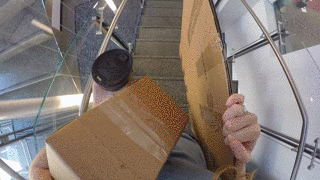
Walk Mindfully, Pocket Your Phone, and Hold the Rail!
As we approach the longest night of the year here in the Northern Hemisphere, with rain often in the picture, leaves on the sidewalks and stairways, and holiday decorations almost within easy reach, this is a crucial time for slip, trip, and fall prevention both at the Lab and at home.
Let’s walk (and drive and bike) mindfully, which includes paying attention to our surroundings rather than the virtual world in handheld devices.
Use handrails on stairways and steep walkways, and clean up slippery spills before others come upon them unawares.
PUBLICATIONS AND PRESENTATIONS
BELLA Center
Refereed literature
A. Gonoskov, T.G. Blackburn, M. Marklund, S. S. Bulanov. “Charged particle motion and radiation in strong electromagnetic fields,” Review of Modern Physics 94, 045001 (2022), https://doi.org/10.1103/RevModPhys.94.045001
Z. Gong, S. S. Bulanov, T. Toncian, “A review, Energy-chirp compensation of laser-driven ion beams enabled by structured targets,” Physical Review Research 4, L042031 (2022), https://doi.org/10.1103/PhysRevResearch.4.L042031
M. Turner, S. S. Bulanov, C. Benedetti, A. J. Gonsalves, W. P. Leemans, K. Nakamura, J. van Tilborg, C. B. Schroeder, C. G. R. Geddes, E. Esarey, “Strong-Field QED Experiments using the BELLA PW Laser Dual Beamlines,” European Physical Journal D 76, 205 (2022), https://doi.org/10.1140/epjd/s10053-022-00535-y
Invited talks
S. Bulanov, “Advanced Ion Acceleration Mechanisms,” 20th Advanced Accelerator Concepts Workshop, Hauppauge, NY, USA, 6-11 November 2022
Fusion Science & Ion Beam Technology
V. Ivanov, J. Simoni, Y. Lee, W. Liu, K. Jhuria, W. Redjem, Y. Zhiyenbayev, C. Papapanos, W. Qarony, B. Kanté, A. Persaud, T. Schenkel, L. Z. Tan, “Effect of localization on photoluminescence and zero-field splitting of silicon color centers,” Physical Review B 106, 134107 (17 October 2022), https://doi.org/10.1103/PhysRevB.106.134107
Accelerator Modeling Program
Refereed literature
Y. Zhao, R. Lehe, A. Myers, M. Thévenet, A. Huebl, C. B. Schroeder, J.-L. Vay. “Plasma electron contribution to beam emittance growth from Coulomb collisions in plasma-based accelerators,” Physics of Plasmas 29, 103109 (2022), https://doi.org/10.1063/5.0102919
R. Lehe, A. Blelly, L. Giacomel, R. Jambunathan, J.-L. Vay, ”Absorption of charged particles in perfectly matched layers by optimal damping of the deposited current,” Physical Review E 106, 045306 (2022), https://doi.org/10.1103/PhysRevE.106.045306
L. Fedeli, A. Huebl, F. Boillod-Cerneux, T. Clark, K. Gott, C. Hillairet, S. Jaure, A. Leblanc, R. Lehe, A. Myers, C. Piechurski, M. Sato, N. Zaïm, W. Zhang, J.-L. Vay, H. Vincenti, “Pushing the Frontier in the Design of Laser-Based Electron Accelerators with Groundbreaking Mesh-Refined Particle-In-Cell Simulations on Exascale-Class Supercomputers,” 2022 SC22: International Conference for High Performance Computing, Networking, Storage and Analysis (SC), Dallas, TX, US, 2022 pp. 25-36
Invited talks
L. Fedeli, A. Huebl, (J.-L. Vay), and H. Vincenti, “Pushing the Frontier in the Design of Laser-Based Electron Accelerators with Groundbreaking Mesh-Refined Particle-In-Cell Simulations on Exascale-Class Supercomputers”, 2022 SC22: International Conference for High Performance Computing, Networking, Storage and Analysis (SC), Dallas, TX, US, 14-18 November 2022
A. Huebl, “From Compact Plasma Particle Sources to Advanced Accelerators with Modeling at Exascale”, AAC 2022, Long Island, NY, 4-11 November 2022
R. Lehe, “Bayesian Optimization of Plasma-based Particle Accelerators”, ODSL seminar (Origins Data Science Laboratory, https://www.origins-cluster.de/en/infrastructure/odsl), Germany, 28 October 2022
J. Qiang, “Space-charge simulation using a quantum Schrodinger method”, 5th ICFA Mini-Workshop on Space Charge, Knoxville, TN, 24-26 October 2022
J.-L. Vay, “Overview and status of space charge simulation codes”, 5th ICFA Mini-Workshop on Space Charge, Knoxville, TN, 24-26 October 2022
J.-L. Vay, “Next Generation Simulation Tools for the Modeling of Beam Dynamics and Electron Clouds in Particle Accelerators”, ECLOUD’22, La Biodola Bay, Isola d’Elba, Italy, 25-28 September 2022
R. Lehe, “Applications of machine learning to plasma-based acceleration”, EuroNNAc Special Topics Workshop, La Biodola Bay, Isola d’Elba, Italy, 18-24 September 2022
Berkeley Accelerator Controls and Instrumentation (BACI) Program
Refereed literature
D. Wang, Q. Du, T. Zhou, A. Gilardi, M. Kiran, B. Mohammed, D. Li, R. Wilcox, “Machine Learning Pattern Recognition Algorithm With Applications to Coherent Laser Combination,” IEEE Journal of Quantum Electronics 58, 6, 1-9, 2022, https://doi.org/10.1109/JQE.2022.3204437
Invited talks
D. Wang, “Machine-learning and active feedback control of coherent combining of fiber lasers for plasma accelerators”, AAC 2022, Long Island, NY, 4-11 November 2022
T. Shen, D. Wang, “The margin of safety of quench protection of high temperature superconducting magnets,” The Applied Superconductivity Conference 2022, Honolulu, Hawaii convention center, 23-28 October 2022
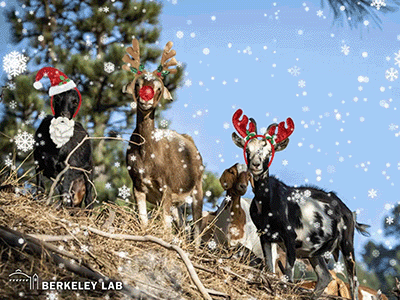
Here’s wishing you and yours happy holidays and a safe return in the new year!
Follow us on social media
Contact
For more information on ATAP News articles, contact Carl A. Williams.
Written by Carl A. Williams or other authors as credited
